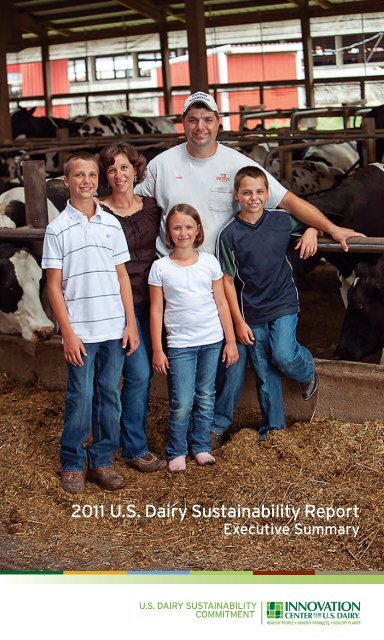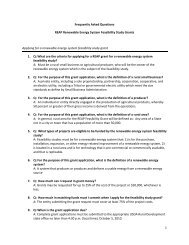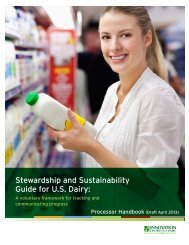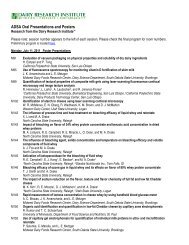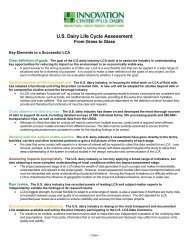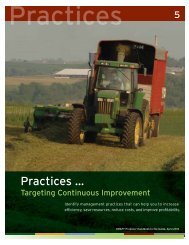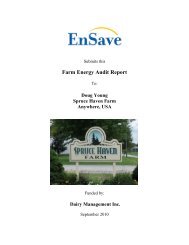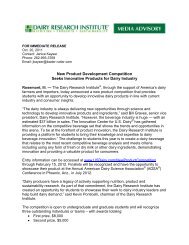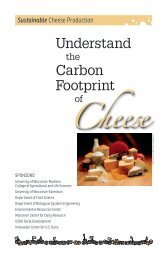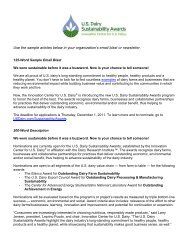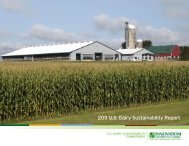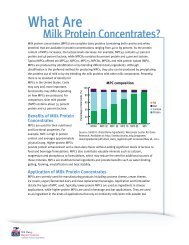2011 U.S. Dairy Sustainability Report Executive Summary
2011 U.S. Dairy Sustainability Report Executive Summary
2011 U.S. Dairy Sustainability Report Executive Summary
You also want an ePaper? Increase the reach of your titles
YUMPU automatically turns print PDFs into web optimized ePapers that Google loves.
<strong>2011</strong> U.S. <strong>Dairy</strong> <strong>Sustainability</strong> <strong>Report</strong><br />
<strong>Executive</strong> <strong>Summary</strong><br />
U.S. DAIRY SUSTAINABILITY<br />
COMMITMENT
Welcome<br />
Welcome to the <strong>2011</strong> U.S. <strong>Dairy</strong> <strong>Sustainability</strong> <strong>Report</strong> <strong>Executive</strong><br />
<strong>Summary</strong>, a condensed version of the full sustainability report,<br />
which is available at US<strong>Dairy</strong>.com/<strong>Sustainability</strong>/<strong>Report</strong>. This<br />
report summarizes efforts led by the Innovation Center for U.S.<br />
<strong>Dairy</strong> ® to support the industry’s sustainability commitment.<br />
Taking the long view, we recognize that the dairy industry<br />
must meet growing global food needs efficiently and<br />
responsibly, while conserving the planet’s precious resources.<br />
Accordingly, sustainability has become a key business strategy<br />
for the industry and its future development.<br />
Over the years, we have been addressing sustainability challenges and identifying<br />
opportunities across the dairy value chain. Highlights of our <strong>2011</strong> efforts, which are<br />
described further inside, include:<br />
> Putting science into the hands of decision makers: Building upon life cycle assessment<br />
(LCA) findings, we developed and tested a suite of tools that help dairy farms and<br />
companies adopt beneficial and sustainable outcomes.<br />
> Developing a measurement and reporting framework: We launched the <strong>Sustainability</strong><br />
Measurement and <strong>Report</strong>ing Framework for U.S. <strong>Dairy</strong>, an industrywide initiative to create<br />
a standard framework for measuring and communicating the environmental, social and<br />
economic aspects and impacts of the industry.<br />
> Recognizing innovation excellence: We partnered with stakeholders to launch the U.S.<br />
<strong>Dairy</strong> <strong>Sustainability</strong> Awards program, which recognizes efforts that deliver outstanding<br />
benefit to business, community and the environment.<br />
We are prepared and committed to build on the momentum we have established and look<br />
forward to hearing your thoughts about our progress at InnovationCenter@US<strong>Dairy</strong>.com.<br />
Tom Gallagher<br />
CEO, Innovation Center for U.S. <strong>Dairy</strong><br />
and <strong>Dairy</strong> Management Inc.<br />
250<br />
Stakeholder Participation<br />
(number of formal participants)<br />
834<br />
Each year, an increasing number of stakeholders from<br />
within and outside of the dairy industry contribute<br />
time and expertise by serving as members of the<br />
<strong>Sustainability</strong> Council (which added 22 new members<br />
in <strong>2011</strong>) and Innovation Center-led project teams<br />
and working groups. We also benefit from working<br />
with our key partners: Center for Advanced Energy<br />
Studies, U.S. Department of Agriculture (USDA) and<br />
World Wildlife Fund.<br />
<strong>Sustainability</strong><br />
Vision<br />
We commit to being<br />
leaders in sustainability,<br />
ensuring the health and<br />
well-being of our planet,<br />
communities, consumers<br />
and the industry.<br />
Larry Jensen<br />
Chair, Innovation Center Board of Directors<br />
and President, Leprino Foods Company<br />
Supplemental Funding<br />
(cash and in-kind contributions)<br />
0<br />
2008 2009 2010 <strong>2011</strong> 2008 2009 2010 <strong>2011</strong><br />
$10M<br />
8<br />
6<br />
4<br />
2<br />
$1.45M<br />
$8M<br />
Funding from investors continues to augment farmer<br />
support from the checkoff program. Supplemental<br />
funding includes grants, awards, financial support<br />
from key stakeholders and in-kind contributions<br />
from formal stakeholder participation. <strong>2011</strong> funding<br />
increased by 21 percent from 2010 and included $1.16<br />
million from USDA’s Natural Resources Conservation<br />
Service Conservation Innovation Grants.<br />
<strong>Sustainability</strong> and Nutrition<br />
Consumers increasingly expect that we not only produce<br />
high-quality and great-tasting products at an affordable price,<br />
but that we produce those products responsibly by protecting<br />
natural resources and supporting communities. As such, the U.S.<br />
dairy industry is taking a leading role in promoting sustainability<br />
and providing consumers with the nutritious dairy products<br />
they want in a way that makes our industry, the earth and its<br />
people economically, environmentally and socially better — now<br />
and for future generations.<br />
“It’s hard to find<br />
any other single<br />
food that will give<br />
you the levels of<br />
nutrients you get<br />
in dairy.”<br />
Robert P. Heaney, MD<br />
Professor of Medicine at<br />
Creighton University School<br />
of Medicine<br />
What’s in this glass is at the heart of all we do.<br />
Milk is a valuable source of essential nutrients that promote good health: calcium,<br />
potassium, vitamins A, D and B12, protein, phosphorus, riboflavin, magnesium and zinc.<br />
ENVIRONMENTAL<br />
Innovations and efficiency<br />
improvements have enabled<br />
the industry to reduce the<br />
environmental impact of a<br />
gallon of milk.<br />
SINCE 1944:<br />
90% less cropland<br />
76% less manure<br />
65% less water<br />
63% less carbon<br />
We are continuously<br />
improving through<br />
partnerships,<br />
research and<br />
projects.<br />
OUR FIRST<br />
GOAL<br />
25%<br />
GREENHOUSE<br />
GAS REDUCTION<br />
FOR FLUID MILK<br />
BY 2020<br />
~25¢<br />
LOW COST<br />
PER SERVING<br />
SOCIAL<br />
A wholesome choice for a<br />
healthy, active lifestyle, dairy<br />
products taste great and<br />
deliver essential nutrients.<br />
HEALTH BENEFITS:<br />
Bone health<br />
Weight management<br />
Exercise recovery<br />
ECONOMIC<br />
• <strong>Dairy</strong> products are affordable and readily available.<br />
• Milk is the lowest-cost food source of dietary calcium.<br />
• Adequate dairy consumption can lower risk of certain chronic<br />
diseases, which has the potential to lower healthcare costs<br />
by as much as $200 billion over a five-year period.<br />
• <strong>Dairy</strong> farms support rural economies in all 50 states.<br />
>90%<br />
OF SCHOOLS PROVIDE<br />
LOW-FAT AND/OR<br />
NON-FAT MILK<br />
Citations are provided in the full version of this report available at US<strong>Dairy</strong>.com/<strong>Sustainability</strong>/<strong>Report</strong>.<br />
18%<br />
OF PROTEIN<br />
IN AMERICAN<br />
DIET IS<br />
PROVIDED<br />
BY DAIRY<br />
PRODUCTS
Our Approach<br />
The Innovation Center is leading sustainability efforts in four key areas: research, goals, innovation projects, and measurement and reporting.<br />
2008 – 2009 2010 <strong>2011</strong> 2012 2013<br />
BEGINNING WITH SCIENCE: LCA research helps us understand the industry’s environmental impacts and prioritize improvement efforts across the dairy value chain.<br />
Greenhouse Gas (GHG) LCA for Fluid Milk – Completed in 2012; findings submitted for publication.<br />
GHG Results: 17.6 lbs. of carbon dioxide equivalents (CO 2<br />
e) per gallon of milk consumed.<br />
Comprehensive LCA for Fluid Milk – Started with focus on water with ongoing study of land use, nutrient cycles and other impacts<br />
On-farm water assessment completed in <strong>2011</strong>; findings to be released in 2012.<br />
Processing and Packaging LCA – Completed in <strong>2011</strong>; findings to be released in 2012.<br />
Comprehensive LCA for Cheese – Completed for Cheddar, mozzarella and natural<br />
cheese in <strong>2011</strong>; with initial GHG results released.<br />
GHG Results: Lbs. CO 2<br />
e per lb. of cheese consumed<br />
Cheddar<br />
8.7<br />
Mozzarella<br />
7.5<br />
Natural Cheese<br />
8.3<br />
SETTING GOALS: We set voluntary industrywide goals and published a roadmap to achieve the first goal: reduce GHG emissions for fluid milk by 25 percent by 2020.<br />
TRANSFORMING RESEARCH INTO RESULTS: Our GHG reduction projects aim to reduce GHG emissions by approximately 11 percent and deliver an estimated $238M in business value across the value chain.<br />
MEASURING AND REPORTING: Research findings contribute to the development of an industrywide framework to measure and report sustainability performance.<br />
CONTRIBUTION OF U.S. DAIRY INDUSTRY TO U.S. GHG EMISSIONS<br />
U.S. GHG Emissions = 7,168 Tg CO 2<br />
e<br />
U.S. <strong>Dairy</strong> Industry: ~2%<br />
The GHG LCA for Fluid Milk, in conjunction<br />
with other studies, shows that dairy<br />
contributes less than 2 percent of total<br />
U.S. GHG emissions.<br />
<strong>Sustainability</strong> Measurement and <strong>Report</strong>ing Framework for U.S. <strong>Dairy</strong> project launched.<br />
Fall <strong>2011</strong>–Summer 2012: Develop guiding principles; identify and define indicators<br />
for initial topics:<br />
Economic: local economic impacts<br />
and product differentiation<br />
Environmental: energy, GHG emissions,<br />
water quantity and quality<br />
Social: working conditions, animal care,<br />
community contributions<br />
Summer: public review of draft<br />
guiding principles and environmental<br />
indicators and metrics.<br />
Winter: public review of social and<br />
economic indicators; update principles<br />
and Framework.<br />
January: Submission of draft Framework<br />
to Innovation Center Board for approval.<br />
Topics for consideration after 2012:<br />
Economic: value across the supply<br />
chain, financials and others<br />
Environmental: waste, biodiversity/<br />
land use, crop production and others<br />
Social: food safety, health and nutrition,<br />
and others<br />
As part of the Framework project, work is under way to identify indicators to measure and report on the social and economic dimensions of the dairy industry.<br />
SOCIAL<br />
The dairy industry is an integral part of our nation’s heritage: from the role that nutritious<br />
dairy products play in our diet to the strong ties with our communities.<br />
> Workforce: One of dairy’s strongest community ties lies in the approximately 900,000<br />
jobs created by our industry. As such, we place a high value on workforce availability<br />
and retention (an industry challenge), safety, training and employee benefits.<br />
> Animal Care: In late 2010, the National Milk Producers Federation started the National<br />
<strong>Dairy</strong> FARM Program: Farmers Assuring Responsible Management (FARM), a nationwide<br />
verifiable program that addresses animal well-being. At year-end <strong>2011</strong>, nearly half of the<br />
nation’s milk supply came from participating producers.<br />
> Community Contributions: Individually and collectively, companies across the industry<br />
actively support charitable hunger relief and food aid efforts, and raise awareness<br />
of healthy lifestyle choices that help combat issues such as malnutrition and obesity.<br />
America’s dairy producers have pledged $250 million over five years to the Fuel Up to<br />
Play 60 program to improve children’s health.<br />
ECONOMIC<br />
<strong>Dairy</strong>’s supply chain generates economic benefits at the local, regional and national levels<br />
through employment, local tax revenues and purchases of products and services. Every<br />
dollar spent locally by a dairy producer creates a multiplier effect of more than two and a<br />
half times the original dollar spent.<br />
> The United States is the largest producer of cow’s milk in the world, and dairy is the<br />
fourth largest agricultural commodity in the U.S. <strong>Dairy</strong>’s on-farm revenues are $31.4<br />
billion, contributing 10 percent of total receipts from sales of agricultural commodities.<br />
> Farms and dairy processors operate throughout all 50 states.<br />
9.1 MILLION COWS<br />
ON MORE THAN<br />
53,000 FARMS<br />
PRODUCED<br />
192.8 BILLION<br />
POUNDS OF MILK<br />
1,200<br />
DAIRY PLANTS<br />
PRODUCED A<br />
VARIETY OF DAIRY<br />
PRODUCTS<br />
AMERICANS<br />
SPENT ~6%<br />
OF THEIR<br />
FOOD BUDGETS<br />
ON DAIRY
<strong>Dairy</strong> Value Chain: Impacts, Opportunities and <strong>2011</strong> Project Accomplishments<br />
FEED PRODUCTION MILK PRODUCTION PROCESSING<br />
PACKAGING<br />
TRANSPORTATION/<br />
DISTRIBUTION RETAIL CONSUMER<br />
KEY ENVIRONMENTAL IMPACTS based on completed and ongoing LCA research<br />
GHG EMISSIONS<br />
key<br />
sources<br />
WATER QUANTITY &<br />
QUALITY<br />
ADDITIONAL ASPECTS<br />
key topics<br />
IMPROVEMENT OPPORTUNITIES<br />
GHG REDUCTIONS<br />
WATER MANAGEMENT<br />
key approaches<br />
fertilizer production,<br />
energy use<br />
biodiversity, land use<br />
energy efficiency,<br />
agricultural systems<br />
improvements<br />
cows (enteric),<br />
manure, energy use<br />
biodiversity, land use,<br />
air quality<br />
feed efficiency,<br />
manure management,<br />
energy efficiency<br />
energy use<br />
energy efficiency,<br />
new technology<br />
energy use,<br />
materials<br />
fuel use,<br />
refrigerants<br />
energy use,<br />
refrigerants<br />
unused/<br />
expired<br />
products<br />
packaging materials waste to landfill waste to<br />
landfill<br />
energy efficiency,<br />
sustainable materials<br />
fuel efficiency, fuel<br />
type, driver habits<br />
energy efficiency,<br />
waste reduction,<br />
recycling<br />
waste<br />
reduction,<br />
recycling<br />
GHG REDUCTION PROJECTS: <strong>2011</strong> ACCOMPLISHMENTS<br />
ON FARM<br />
BEYOND THE FARM<br />
Farm Smart TM<br />
Development and beta test of the Farm<br />
Smart toolkit to support dairy and crop<br />
production management decision-making<br />
Farm Energy Efficiency TM<br />
Launch of online resource:<br />
US<strong>Dairy</strong>.com/SaveEnergy<br />
310 energy audits conducted<br />
Estimated GHGs reduced:<br />
700 metric tons<br />
Estimated energy cost savings:<br />
$148,000<br />
Cow of the Future TM<br />
Publication of paper on research<br />
priorities for reducing dairy cow<br />
enteric emissions<br />
<strong>Dairy</strong> Power TM /<br />
Biogas Capture and Transport TM<br />
15 anaerobic manure digesters<br />
brought online in <strong>2011</strong> to produce<br />
renewable biogas<br />
Estimated GHGs destroyed:<br />
1.2 million metric tons<br />
Estimated GHGs avoided:<br />
301,000 metric tons<br />
<strong>Dairy</strong> Plant Smart TM<br />
and Next Generation Cleaning TM<br />
Development and beta test of two tools within<br />
the <strong>Dairy</strong> Plant Smart toolkit to support energy<br />
management in fluid milk pr ocessing plants<br />
Processing and Packaging LCA TM<br />
Study findings on processing and packaging<br />
white and value-added milks and creamers<br />
submitted for peer review to be published in 2012<br />
Next Generation Processing: UV TM<br />
Proposed inclusion of ultraviolet (UV) illumination<br />
in Grade “A” Pasteurized Milk Ordinance as a<br />
technology to adjunct pasteurization process and<br />
lower energy usage<br />
<strong>Dairy</strong> Fleet Smart TM<br />
Development and beta test of <strong>Dairy</strong> Fleet Smart<br />
tool to support fuel and cost reductions in milk<br />
transport and distribution of dairy products<br />
Learn more about each project at US<strong>Dairy</strong>.com/<strong>Sustainability</strong> and in the <strong>2011</strong> U.S. <strong>Dairy</strong> <strong>Sustainability</strong> <strong>Report</strong>.
2012 U.S. <strong>Dairy</strong> <strong>Sustainability</strong> Award Recipients<br />
In <strong>2011</strong>, the Innovation Center launched the U.S. <strong>Dairy</strong> <strong>Sustainability</strong> Awards program<br />
with award sponsors Elanco, U.S. <strong>Dairy</strong> Export Council ® and the Center for Advanced<br />
Energy Studies/Idaho National Laboratory. The awards recognize efforts that advance the<br />
sustainability of the dairy industry by delivering benefits to business, community and the<br />
environment. Program supporters include World Wildlife Fund, USDA, MilkPEP and the <strong>Dairy</strong><br />
Research Institute. ®<br />
We are honored to present the inaugural award recipients.<br />
Elanco Award for Outstanding <strong>Dairy</strong> Farm <strong>Sustainability</strong><br />
Blue Spruce Farm | Bridport, Vermont<br />
Holsum Dairies, LLC | Hilbert, Wisconsin<br />
Werkhoven <strong>Dairy</strong>, Inc. | Monroe, Washington<br />
U.S. <strong>Dairy</strong> Export Council Award for Outstanding <strong>Dairy</strong> Processing &<br />
Manufacturing <strong>Sustainability</strong><br />
Darigold, Inc. | Seattle, Washington<br />
Honorable Mention<br />
Oakhurst <strong>Dairy</strong> | Portland, Maine<br />
Center for Advanced Energy Studies/Idaho National Laboratory Award<br />
for Outstanding Achievement in Energy<br />
DF-AP, LLC | Gooding, Idaho<br />
Brubaker Farms | Mount Joy, Pennsylvania<br />
The Innovation Center for U.S. <strong>Dairy</strong> provides a forum for the dairy industry to work together precompetitively<br />
to address barriers and opportunities to foster innovation and increase sales. The Innovation<br />
Center aligns the collective resources of the U.S. dairy industry to offer consumers nutritious dairy<br />
products and ingredients, and promote the health of people, communities, the planet and the industry.<br />
The Innovation Center was founded through the farmer-funded dairy checkoff program in 2008.<br />
For more information about the Innovation Center, visit US<strong>Dairy</strong>.com.<br />
For citations and references, and to view the full version of this report which follows the Global<br />
<strong>Report</strong>ing Initiative <strong>Report</strong>ing Framework V3.1, visit US<strong>Dairy</strong>.com/<strong>Sustainability</strong>/<strong>Report</strong>.<br />
We welcome your feedback on this report at InnovationCenter@US<strong>Dairy</strong>.com.<br />
©2012, Innovation Center for U.S. <strong>Dairy</strong>. All rights reserved.


